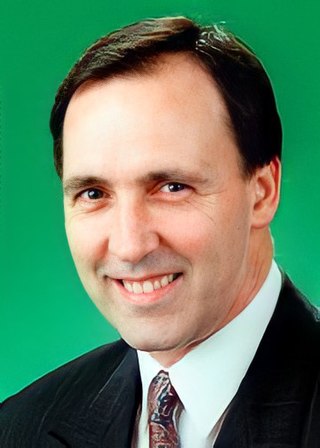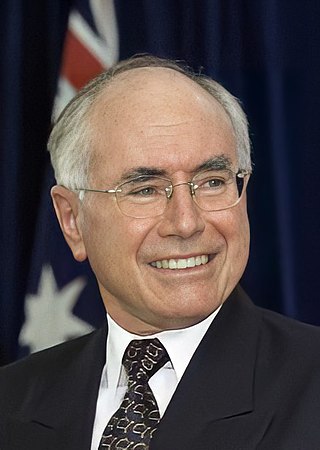
Robert James Lee Hawke was an Australian politician who served as the 23rd prime minister of Australia, from 1983 to 1991, holding office as the leader of the Australian Labor Party (ALP). Previously he was the president of the Australian Council of Trade Unions from 1969 to 1980 and president of the Labor Party national executive from 1973 to 1978.

The Liberal Party of Australia is a centre-right political party in Australia. The party is one of the two major parties in Australian politics, the other being the Australian Labor Party. The Liberal Party was founded in 1944 as the successor to the United Australia Party, and has since become one of the most successful political parties in Australia's history.

Paul John Keating is an Australian former politician and trade unionist who served as the 24th prime minister of Australia, from 1991 to 1996, holding office as the leader of the Australian Labor Party (ALP). He previously served as the treasurer of Australia in the Hawke government from 1983 to 1991 and as the 7th deputy prime minister of Australia from 1990 to 1991.

John Robert Hewson AM is an Australian former politician who served as leader of the Liberal Party from 1990 to 1994. He led the Liberal-National Coalition to defeat at the 1993 Australian federal election.

Goods and Services Tax (GST) in Australia is a value added tax of 10% on most goods and services sales, with some exemptions and concessions. GST is levied on most transactions in the production process, but is in many cases refunded to all parties in the chain of production other than the final consumer.

The 1993 Australian federal election was held to determine the members of the 37th Parliament of Australia. It was held on 13 March 1993. All 147 seats of the Australian House of Representatives and 40 seats of the 76-seat Australian Senate were up for election. The incumbent government of the centre-left Australian Labor Party led by Paul Keating, the Prime Minister of Australia, was re-elected to a fifth term, defeating the centre-right Liberal/National Coalition led by Opposition Leader John Hewson of the Liberal Party of Australia, and coalition partner Tim Fischer of the National Party of Australia. This was the first, and to date only, time the Labor Party won a fifth consecutive election.
The following lists events that happened during 1992 in Australia.
The following lists events that happened during 1993 in Australia.
The following lists events that happened during 1991 in Australia.

The 1987 Australian federal election was held in Australia on 11 July 1987, following the granting of a double dissolution on 5 June by the Governor-General Sir Ninian Stephen. Consequently, all 148 seats in the House of Representatives as well as all 76 seats in the Senate were up for election. The incumbent Australian Labor Party, led by Prime Minister Bob Hawke, defeated the opposition Liberal Party of Australia, led by John Howard and the National Party of Australia led by Ian Sinclair. This was the first, and to date only, time the Labor Party won a third consecutive election.

John Winston Howard is an Australian former politician who served as the 25th prime minister of Australia, from 1996 to 2007, holding office as leader of the Liberal Party of Australia. His eleven-year tenure as prime minister is the second-longest in Australian history, behind only Sir Robert Menzies. Howard previously served as the 29th treasurer of Australia from 1977 to 1983 under Prime Minister Malcolm Fraser. He has also been the oldest living Australian prime minister since the death of Bob Hawke in May 2019.
Peter John Knott was an Australian politician, elected as a member of the Australian House of Representatives. He represented Gilmore from 1993 to 1996 for the Australian Labor Party (ALP).
Fightback! was a 650-page economic policy package document proposed by John Hewson, federal leader of the Liberal Party of Australia and Leader of the Opposition from 1990 to 1994. It represented the start of their new "dry", economic liberal future policy direction, very different from the Keynesianism they previously practised. The package was part of their unsuccessful policy platform at the 1993 election.

The Howard government refers to the federal executive government of Australia led by Prime Minister John Howard between 11 March 1996 and 3 December 2007. It was made up of members of the Liberal–National Coalition, which won a majority of seats in the House of Representatives at four successive elections. The Howard government commenced following victory over the Keating government at the 1996 federal election. It concluded with its defeat at the 2007 federal election by the Australian Labor Party, whose leader Kevin Rudd then formed the first Rudd government. It was the second-longest government under a single prime minister, with the longest having been the second Menzies government (1949–1966).

The Hawke government was the federal executive government of Australia led by Prime Minister Bob Hawke of the Australian Labor Party (ALP) from 1983 to 1991. The government followed the Liberal-National Coalition Fraser government and was succeeded by another Labor administration, the Keating government, led by Paul Keating after an internal party leadership challenge in 1991. Keating was Treasurer through much of Hawke's term as Prime Minister and the period is sometimes termed the Hawke-Keating government.

The Keating government was the federal executive government of Australia led by Prime Minister Paul Keating of the Australian Labor Party from 1991 to 1996. The government followed on from the Hawke government after Paul Keating replaced Bob Hawke as Labor leader in an internal party leadership challenge in 1991. Together, these two governments are often collectively described as the Hawke-Keating government. The Keating government was defeated in the 1996 federal election and was succeeded by the John Howard's Coalition government.
Michael Robert Willesee, was an Australian television journalist, interviewer and presenter.

A leadership spill of the Australian Labor Party (ALP), the party of government in the Parliament of Australia, was held on 19 December 1991, the second spill in a year. Backbencher and former Treasurer Paul Keating defeated Prime Minister Bob Hawke, who had led Labor for eight and a half years.
The early 1990s recession saw a period of economic downturn affect much of the world in the late 1980s and early 1990s. The economy of Australia suffered its worst recession since the Great Depression.
The Shadow Ministry of John Hewson was the opposition Coalition shadow ministry of Australia from 11 April 1990 to 23 May 1994, opposing the Australian Labor Party's Hawke–Keating government.





